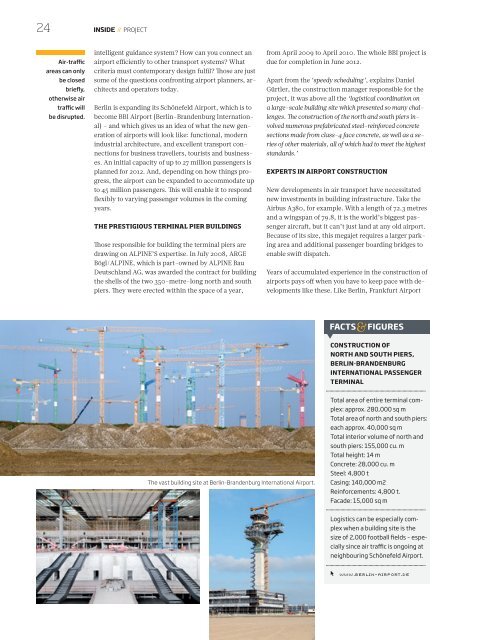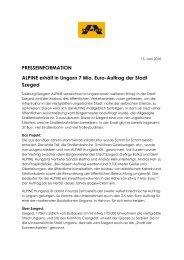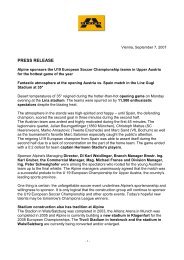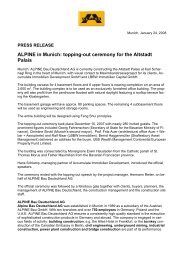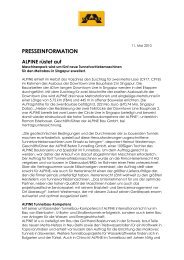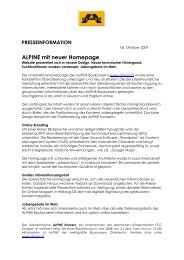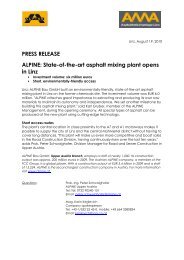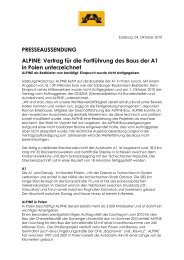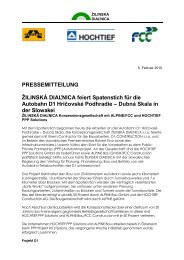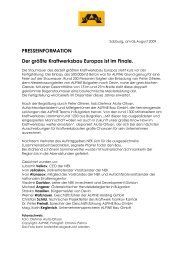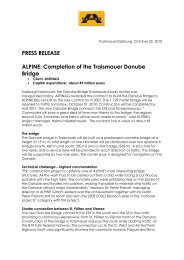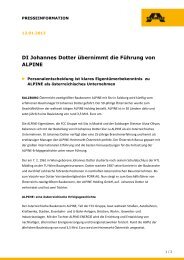DAM IMPRESSIVE
DAM IMPRESSIVE
DAM IMPRESSIVE
You also want an ePaper? Increase the reach of your titles
YUMPU automatically turns print PDFs into web optimized ePapers that Google loves.
24 // PROJECT<br />
Air-traffic<br />
areas can only<br />
be closed<br />
briefly,<br />
otherwise air<br />
traffic will<br />
be disrupted.<br />
intelligent guidance system? How can you connect an<br />
airport efficiently to other transport systems? What<br />
criteria must contemporary design fulfil? Those are just<br />
some of the questions confronting airport planners, architects<br />
and operators today.<br />
Berlin is expanding its Schönefeld Airport, which is to<br />
become BBI Airport (Berlin-Brandenburg International)<br />
– and which gives us an idea of what the new generation<br />
of airports will look like: functional, modern<br />
industrial architecture, and excellent transport connections<br />
for business travellers, tourists and businesses.<br />
An initial capacity of up to 27 million passengers is<br />
planned for 2012. And, depending on how things progress,<br />
the airport can be expanded to accommodate up<br />
to 45 million passengers. This will enable it to respond<br />
flexibly to varying passenger volumes in the coming<br />
years.<br />
the PReStigiouS teRminal PieR buildingS<br />
Those responsible for building the terminal piers are<br />
drawing on ALPINE’S expertise. In July 2008, ARGE<br />
Bögl/ALPINE, which is part-owned by ALPINE Bau<br />
Deutschland AG, was awarded the contract for building<br />
the shells of the two 350-metre-long north and south<br />
piers. They were erected within the space of a year,<br />
The vast building site at Berlin-Brandenburg International Airport.<br />
from April 2009 to April 2010. The whole BBI project is<br />
due for completion in June 2012.<br />
Apart from the ‘speedy scheduling’, explains Daniel<br />
Gürtler, the construction manager responsible for the<br />
project, it was above all the ‘logistical coordination on<br />
a large-scale building site which presented so many challenges.<br />
The construction of the north and south piers involved<br />
numerous prefabricated steel-reinforced concrete<br />
sections made from class-4 face concrete, as well as a series<br />
of other materials, all of which had to meet the highest<br />
standards.’<br />
eXPeRtS in aiRPoRt ConStRuCtion<br />
New developments in air transport have necessitated<br />
new investments in building infrastructure. Take the<br />
Airbus A380, for example. With a length of 72.3 metres<br />
and a wingspan of 79.8, it is the world’s biggest passenger<br />
aircraft, but it can’t just land at any old airport.<br />
Because of its size, this megajet requires a larger parking<br />
area and additional passenger boarding bridges to<br />
enable swift dispatch.<br />
Years of accumulated experience in the construction of<br />
airports pays off when you have to keep pace with developments<br />
like these. Like Berlin, Frankfurt Airport<br />
fACTS & fIGURES<br />
CONSTRUCTION Of<br />
NORTH AND SOUTH PIERS,<br />
BERLIN-BRANDENBURG<br />
INTERNATIONAL PASSENGER<br />
TERMINAL<br />
Total area of entire terminal complex:<br />
approx. 280,000 sq m<br />
Total area of north and south piers:<br />
each approx. 40,000 sq m<br />
Total interior volume of north and<br />
south piers: 155,000 cu. m<br />
Total height: 14 m<br />
concrete: 28,000 cu. m<br />
Steel: 4,800 t<br />
casing: 140,000 m2<br />
reinforcements: 4,800 t.<br />
Facade: 15,000 sq m<br />
logistics can be especially com-<br />
plex when a building site is the<br />
size of 2,000 football fields – especially<br />
since air traffic is ongoing at<br />
neighbouring Schönefeld Airport.<br />
Ü www.berlin-airport.de


